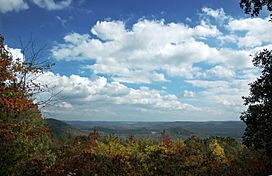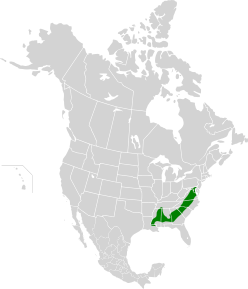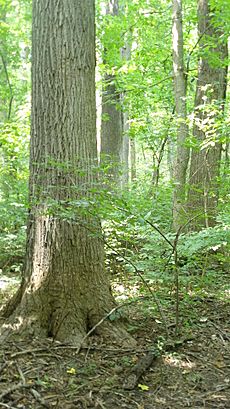Southeastern mixed forests facts for kids
Quick facts for kids Southeastern mixed forests |
|
|---|---|

|
|
 |
|
| Ecology | |
| Realm | Nearctic |
| Biome | Temperate broadleaf and mixed forest |
| Bird species | 212 |
| Mammal species | 66 |
| Geography | |
| Area | 347,800 km2 (134,300 sq mi) |
| Country | United States |
| States | |
| Conservation | |
| Habitat loss | 26.905% |
| Protected | 3.73% |
The Southeastern mixed forests are a special natural area. They are a type of ecoregion (a large area with similar plants and animals) found in the southeastern United States. This area has many different kinds of trees, both broadleaf (like oaks) and evergreen (like pines).
Contents
Where are the Southeastern Mixed Forests?
This amazing forest area covers the Piedmont region. The Piedmont is a plateau between the mountains and the coast. It stretches from New Jersey all the way southwest to Mississippi.
These forests are different from other areas nearby. For example, to the east, at lower elevations, are the Middle Atlantic coastal forests. To the south, you'll find the Southeastern conifer forests. Higher up, to the north and west, are the Appalachian–Blue Ridge forests and the Appalachian mixed mesophytic forests. You can even find small parts of these forests in northern Florida.
What is the Climate Like?
The Southeastern mixed forests have a humid subtropical climate. This means they have hot, humid summers. Winters are usually mild to cool. It rarely gets super cold here. There is also plenty of rain all year round.
Plants and Trees of the Southeastern Forests
This ecoregion is home to many different plants. You'll find lots of oaks (Quercus species) and hickories (Carya species). There are also more than 3,600 other types of native plants and shrubs!
The American chestnut tree used to be very important here. But in the early 1900s, a disease called chestnut blight destroyed most of them. Now, you might still see young chestnut trees. However, the disease often kills them before they can grow big.
Oak and Hickory Forests
The most common oak trees in this area include:
Black and scarlet oaks often grow in open forest areas. Black oaks can even grow by themselves in dry, sunny spots. Chestnut oaks are found on the tops of ridges.
The hickory trees here are easy to spot by their leaves. Their leaves have many smaller leaflets. Common hickories include:
Both of these hickories can grow in many different places. They are found from dry ridges to wetter, cooler spots.
Smaller trees that grow under the taller oaks and hickories include:
- Sassafras
- Hophornbeam
- Green hawthorn
- Flowering dogwood (which has beautiful blooms in spring!)
You'll also find many shrubs, such as:
Two common pine trees are the shortleaf pine and loblolly pine. These pine forests often need fire to grow new trees. Without fire, other hardwood trees might start to take over.
In the northern parts of this ecoregion, you'll find sugar maple trees. These trees can grow well even in shady areas among the oaks and hickories.

Moist Forests (Mesic Forests)
Mesic means moist and cool. These forests grow in rich, fertile soil in places like deep ravines. They also grow on slopes that face north or east, which stay cooler and shadier.
Important trees in these moist forests include:
- American beech
- Tulip tree
- Northern red oak
- White ash
- Black maple
- Sugar maple
- Basswood
- Bitternut hickory
Smaller trees that grow beneath them are pawpaw and painted buckeye. Small patches of these moist forests can also be found in northern Florida.
Mixed Hardwood Forests
These forests grow on moist uplands, in ravines, and on lower slopes. They also grow in flat areas with good drainage. You'll find a mix of trees here, like American beech, tulip tree, and different kinds of oaks and hickories.
Other trees in these mixed forests include:
Just like the other forest types, small areas of these mixed hardwood forests extend into northern Florida.
New Growth Forests (Successional Forests)
Successional forests are areas where new trees are growing after a disturbance, like a farm field being left alone. These forests often have trees like:
Protected Areas in the Southeastern Mixed Forests
Many parts of these forests are protected. This helps keep them healthy for animals and plants. Some of these protected areas include:
- Sumter National Forest
- Uwharrie National Forest
- Bienville National Forest
- Talladega National Forest SW unit
- Oconee National Forest
- Piedmont National Wildlife Refuge
- Sauratown Mountains
- Brushy Mountains (North Carolina)
- South Mountains (North Carolina)
- Arlington Woods, Arlington House, The Robert E. Lee Memorial, Virginia
- Duke Forest
- William B. Umstead State Park
- Eno River State Park
- Guilford College
- Supawna Meadows National Wildlife Refuge
- Pee Dee National Wildlife Refuge in the Great Pee Dee River basin of piedmont North Carolina

